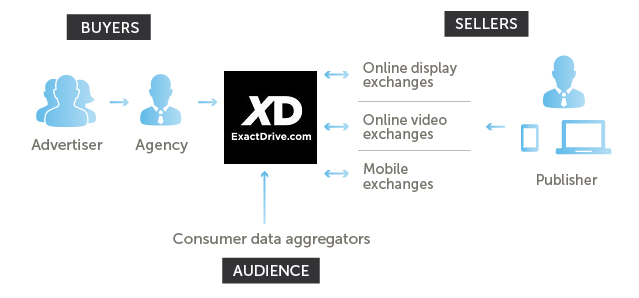 What is digital media planning? Today seems like as good of a day as any to open up a discussion about digital media planning for online advertising campaigns. Have you ever found yourself traveling in a new city, right after it has gotten dark, without a map, no money, hungry, thirsty, and no place to sleep for the night? Well, if you have had such an experience, it’s not very fun, and you probably developed a pretty skewed view of the city and your related experiences. This is because you visited the city without a proper plan and limited information and as a result, you most likely had a stressful and negative experience. You could have been visiting a great city, full of wonderful potential, but without proper planning ahead of time, you had a very difficult time experiencing the full potential of your environment.
What is digital media planning? Today seems like as good of a day as any to open up a discussion about digital media planning for online advertising campaigns. Have you ever found yourself traveling in a new city, right after it has gotten dark, without a map, no money, hungry, thirsty, and no place to sleep for the night? Well, if you have had such an experience, it’s not very fun, and you probably developed a pretty skewed view of the city and your related experiences. This is because you visited the city without a proper plan and limited information and as a result, you most likely had a stressful and negative experience. You could have been visiting a great city, full of wonderful potential, but without proper planning ahead of time, you had a very difficult time experiencing the full potential of your environment.
This is similar to trying to write a digital media plan and execute a digital media buy without an accurate customer profile, client objectives, or useful customer data. You shouldn’t expect to be able to guess and estimate your way through this process and have a successful digital media buy as a result. Yes, you might be lucky a couple of times, but in the long run, your client will become dissatisfied and your competition will sway your client in their direction.
Customer data, media planning, and digital media buying shouldn’t look like three feuding brothers fighting over the same prom date. They should be looked at and utilized as three important parts of the same team that are infinitely most useful and successful when working together versus apart. This is kind of like a boat in the water, the sun at the beach, or having money at a casino – all of these things are a lot better when paired together versus being apart.
For instance, if you had a client that offers online grocery shopping and delivery services you should do more than blindly assume that 100 percent of their customers are young moms visiting food-related websites, reading online recipes, and learning about the latest calorie-counting techniques. Maybe you’re of this opinion because that’s how you live or grew up or maybe that’s what happens in your cousin’s household; heck, maybe you are even partially accurate. Either way, under any scenario, if you’re using guesses and assumptions as to the backbone to your media plan it will dramatically introduce errors and inaccuracies into the digital media buy, which will ultimately lead to wasted advertising budget and limit the overall success of the campaign.
Ask Questions No One Else Is Asking

Let's be clear from the beginning. I am not suggesting to be one of those annoying front row students that loses all of the blood from their hand because they won't stop raising their hand asking questions every 30 seconds. Asking multiple obvious questions is just as disruptive as sitting back and asking one overly complicated question that doesn't have any relevance beyond wanting to sound like the smartest person in the room. I'm talking about good ole fashion logical questions that are wrapped in common sense. Sounds shocking but it's possible.
Get down to the root of WHY a client is requesting certain information or wanting you to answer certain questions then your job will most likely get a lot easier. Why is the client asking about "Look-a-like targeting off first-party cookie segmentation" out of the blue? Why is the client asking how many vegetarian females between the ages of 25-35 live in zip code 90403? Why is the client wanting to upload 150 different banner creatives once a week instead of using dynamic ads?
Challenge your own assumptions while at the same time exploring the "Why" of the question before deciding "What" to do about it or how to answer. Remember, it's okay to dig deeper into a question or a request from a client instead of just reacting and responding. Asking for feedback can be your golden ticket to Willy Wonka's Chocolate Factory of successful online media buying. Just don't act like Grandpa Joe along with the way.
Pull Your Own Red Wagon While Collaborating
Dr. Jim Yong Kim, the 12th president of the World Bank Group, recently wrote an article entitled "What I Learned From Bill Gates". In that article he said, "Research suggests that creativity is less an attribute of individuals than an emergent property that bubbles up within communities of people solving problems together." In other words, innovation comes from collaboration, or don't be an island, or arrogance breeds ignorance or talking and discussing with your colleagues and teammates is a GOOD idea.
Pulling your own red wagon while collaborating refers to the concept that even though being independent and self-motivated at your job is important, so is collaborating with others. Discussing concepts, asking questions, learning what they have done in the past that has worked or failed. Naturally, the ideal goal here is to know when you should pull in external resources and when it is okay to step back into your vacuum, put your head down and get to work.
What is Real-Time Media Buying?

Real-Time media buying is a variation of programmatic buying. It allows advertisers to bid for the right to serve an ad to a particular person, on an impression by impression basis. The technology is an effective way to get the right ad in front of the right person at the right time, and for advertisers, buying ads in real-time is becoming the go-to method to quickly and efficiently execute a branding campaign.
Why We Love Real-Time Media Buying
- Buying and Valuation
Real-time bidding enables brands to bid on individual impressions rather than agreeing to a predetermined price. Buying online media in real-time is cost-effective, reduces waste, and prevents advertisers from overpaying for media. Real-time bidding means brands only pay what an impression is truly worth.
- Targeting Technology
Advertisers are becoming more aware of the benefits of first and third-party data to target desired audiences. With the help of third-party data, vendors and advertisers can create a detailed profile of their target consumer, by modeling the attributes of existing customers. By taking advantage of first-party data, advertisers can optimize their audience based on known quantities – their own customer base. Real-time bidding allows advertisers to access the media they want, for the people they choose.
- Dynamic Optimization and Real-Time Analytics
The ability to update a campaign in real-time is a huge benefit with real-time buying because performance reporting data is made available as the campaign runs. Advertisers can adjust their campaigns when big news stories hit, update their site lists or add/remove ad units from their campaigns on the fly, based on performance.
Programmatic Digital Media Buying
Digital media buying has evolved significantly in the past few years, with the increased utilization of programmatic media buying platforms. Traditionally, advertisers would reach out to publishers and negotiate deals to get their products and services displayed to the masses, but once ad networks came to fruition, the purchase of inventory was possible on a scale not seen previously. Real-time media buying brochure.
Once advertisers learned they could buy bulk inventory through aggregators; real-time ad exchanges emerged, trading impressions that publishers could not sell directly through their in-house sales teams. This has led to the introduction of automated or programmatic media buying, made possible by a technology known as real-time bidding (RTB). Using real-time bidding, brands can deliver better-targeted campaigns; gain richer audience insight, and maximize their marketing ROI.
The technology involved with programmatic buying is having a profound impact on the way that consumers interact with brands, as well as the way that brands develop a greater return on their investments. Programmatic buying, which automates the purchase of media, has demonstrated an unprecedented amount of efficiency in a world where customers are constantly connected to their devices.
As the rise of programmatic buying continues to show promise in the digital world, it's crucial for businesses and brands to stay on top of the latest updates, and understand the powerful potential this strategy has to offer. Following, we'll cover a few of the steps you'll need to consider in developing your own programmatic media buying strategy.
Programmatic Digital Media Buying Strategy
Ask Yourself the Right Questions
Just like in any business strategy, setting yourself up for success means answering the important questions about your long-term, and short-term goals. For instance, are you hoping to simply move goods off the shelves faster, or do you want to change the way that customers think about your brand with a new commercial spot? Programmatic digital media buying can be a highly effective strategy for most businesses - but it only works when it's used correctly. The more time you take to brainstorm your needs with your internal team, the more likely you are to come up with valuable ideas that will prepare you in finding the right partner for success.
Understand the Technology
While you might not need to understand the deeper inner workings of the technology that you use for programmatic media buying - you will at least need a basic understanding of what's going on in your brand. Any programmatic partner that you work with should be willing to answer the various questions you might have regarding the technology that powers your campaigns - so don't be afraid to ask.
For most advertisers, the first step on the programmatic journey will begin with a choice of demand-side-platform - the minimum technology required for effective programmatic buying. The clear view that you've already established for your marketing goals will help you to select the right DSP for you.
Use a Multi-Platform Approach
For some brands, using one DSP is enough to achieve minor goals. However, for many companies, the advantage of trading through multiple demand-side platforms allows them to take advantage of various opportunities. The differing strengths provided by alternate DSPs can be singled out and emphasized to improve the performance of your campaign.
At the same time, having multiple views of the inventory available through different platforms will also help to promote value and competition for your investments, so that you can reach as many customers as possible while limiting your budget.
Focus on Creative
Creative has a significant part to play in any digital marketing strategy, so it only makes sense that it would be crucial from a programmatic perspective too. Programmatic marketing is all about delivering the right message to the right audience, at the best possible time. What's more, this approach will give your creative team the information that they need to improve your branding messages across various platforms.
Make sure that you devote time and effort to delivering an incredible creative, and upgrade that creative whenever possible, using contextual, audience, and environmental signals to provide dynamic content that personally appeals to your market.
Programmatic Isn't a One-Size-Fits-All Solution
Although it might be far more convenient for marketers to simply invest in a pre-made programmatic solution that they can forget about by the end of the day, the truth is that every brand campaign has unique objectives to accomplish. Some will be driven by awareness, whereas others will be looking for specific actions, engagement, or sales. A proactive programmatic media buyer will need to create a custom-made solution by understanding their market, alongside the data they have collected.
Carefully plan out your programmatic strategy, and make sure that the teams you work with speak the same language in terms of measurement. After all, programmatic buying can be highly effective for marketers when they have a clear line of communication between themselves, and the team that is executing or advising a campaign.
In short, ask questions, conduct research, critically analyze the answers you’re given, then repeat the process until all participating members are satisfied. Properly creating and utilizing customer data will give your media plan the best chance to successfully court the digital media buy and result in a happy online advertising marriage.


